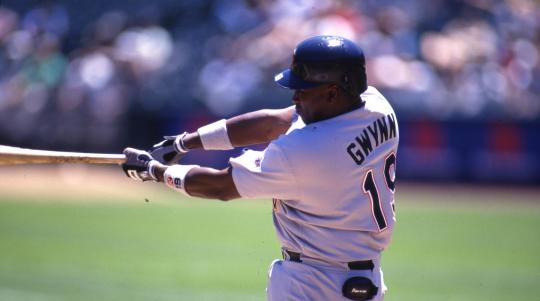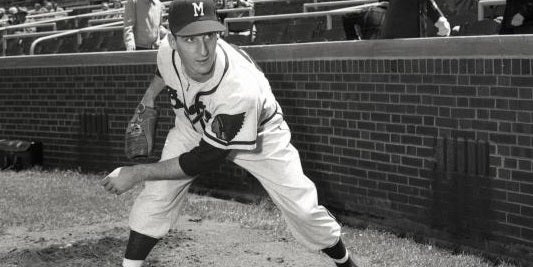Hitting is timing. Pitching is upsetting timing.
Hall of Famer Warren Spahn

PHYSICAL SCIENCE: SCIENCE ON THE SANDLOT
Have you ever wondered about those raised red cotton stitches on a baseball? Sure, they hold the cowhide together, but did you know they also teach an interesting lesson in aerodynamics? Why do some hitters choke up on the bat? Why do some players wear batting gloves? Why is every hit not a home run? What’s the major league math behind wood versus aluminum bats?
Find answers to these questions in the physics of friction, center of mass, forces of motion, the coefficient of restitution, the Magnus effect and other concepts that become fascinating factors in a batter’s ability to launch the long ball.
Maybe Issac Newton couldn’t snap a pop fly, but he can coach you in the surprisingly scientific feat of catching up to a 100-mile-per-hour fastball in just 0.4 seconds and sending it into orbit!
Step out of the dugout and up to the plate as the Baseball Hall of Fame delivers a lively look at science on the sandlot.
THEMATIC UNIT OBJECTIVE
- Examine historical aspects and physical forces involved in playing baseball, relying on museum and library collections, equipment, video and film, testimonials and web features.
- Analyze the physical concepts behind hitting, pitching and fielding as they impact the way baseball is played, including tools that are used and how scientific variables affect choices and approaches to the game.
- Understand the vocabulary and several concepts of physics related to fundamentals of scientific inquiry.
ROOKIE (GRADES 3-5)
LESSON 1 (PRE-VISIT): BASEBOLOGY 101! - PART 1
Students discuss the importance of observation as they focus on the first phase of the Scientific Method.
LESSON 2 (PRE-VISIT): BASEBOLOGY 101! - PART 2
Building on Lesson 1, students focus on the second phase of the Scientific Method as they create experiments to test their hypotheses.
LESSON 3 (PRE-VISIT): FORCES & MOTION
Students discuss different types of forces, and are introduced to Newton's Three Laws of Motion.
LESSON 4: ON-SITE VISIT OR VIDEO CONFERENCE
Students will work with museum teachers to reinforce concepts and ideas introduced in the classroom.
Book your:
LESSON 5 (POST-VISIT): SPEED & DISTANCE
Students will review what they learned about forces and motion during their experience with the Baseball Hall of Fame.
INTERMEDIATE (GRADES 6-8)
LESSON 1 (PRE-VISIT): FORCE PLAY: NEWTON'S 1ST LAW
Students review the concept of forces as they focus on Newton's First Law - The Law of Inertia.
LESSON 2 (PRE-VISIT): SWINGING FOR THE FENCES: NEWTON'S 2ND LAW
Students discuss different variables that affect the distance a hit ball will travel while focusing on Newton's Second Law - The Law of Acceleration.
LESSON 3 (PRE-VISIT): NEWTON'S 3RD LAW
Students determine the effects of Newton's Third Law - The Law of Action/Reaction.
LESSON 4: ON-SITE VISIT OR VIDEO CONFERENCE
Students will work with museum teachers to reinforce concepts and ideas introduced in the classroom.
Book your:
LESSON 5 (POST-VISIT): NEWTON PLAYS BALL
Students will review what they learned about forces and motion during their experience with the Baseball Hall of Fame.
ADVANCED (GRADES 9-12)
LESSON 1 (PRE-VISIT): FORCE PLAY: NEWTON'S 1ST LAW
Students review the concept of forces as they focus on Newton's First Law- The Law of Inertia.
LESSON 2 (PRE-VISIT): SWINGING FOR THE FENCES: NEWTON'S 2ND LAW
Students discuss different variables that affect the distance a batted ball will travel while focusing on Newton's Second Law- The Law of Acceleration.
LESSON 3 (PRE-VISIT): NEWTON'S 3RD LAW
Students determine the effects of Newton's Third Law- The Law of Action/Reaction.
LESSON 4: ON-SITE VISIT OR VIDEO CONFERENCE
Students will work with museum teachers to reinforce concepts and ideas introduced in the classroom.
Book your:
LESSON 5 (POST-VISIT): NEWTON PLAYS BALL
Students will review what they learned about forces and motion during their experience with the Baseball Hall of Fame.
COMMON CORE STANDARDS
CCSS ELA CONTENT: RI.3.3/4.3/5.3, RI.3.4/4.4/5.4, W.3.7/4.7/5.7, W.3.8/4.8/5.8
MCREL STANDARDS: Science.Level 2.Standards 9,10,11,12
EXPLORE OUR CURRICULUM
The Museum currently offers 15 baseball-themed curriculum components that provide interactive and meaningful learning engagement.
PLAN A VIRTUAL FIELD TRIP
The next best thing to visiting the National Baseball Hall of Fame Museum is participating in a Virtual Field Trip. The Museum's award winning programs bring the wonders of Cooperstown to the classroom.
PLAN A FIELD TRIP
The National Baseball Hall of Fame and Museum proudly presents fun-filled, content rich experiences for students from grades 3 to 12. Our field trips are all aligned with National Learning Standards.
EXPLORE OUR CURRICULUM
The Museum currently offers 15 baseball-themed curriculum components that provide interactive and meaningful learning engagement.
PLAN A VIRTUAL FIELD TRIP
The next best thing to visiting the National Baseball Hall of Fame Museum is participating in a Virtual Field Trip. The Museum's award winning programs bring the wonders of Cooperstown to the classroom.
PLAN A FIELD TRIP
The National Baseball Hall of Fame and Museum proudly presents fun-filled, content rich experiences for students from grades 3 to 12. Our field trips are all aligned with National Learning Standards.

